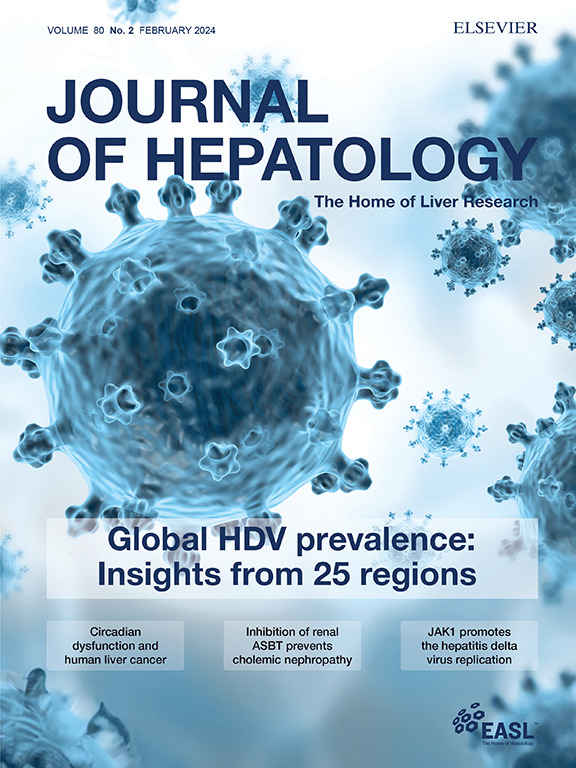A read-through circular RNA RCRIN inhibits metabolic dysfunction-associated steatotic liver disease
IF 26.8
1区 医学
Q1 GASTROENTEROLOGY & HEPATOLOGY
引用次数: 0
Abstract
Background & Aims
The molecular mechanisms underlying metabolic dysfunction-associated steatotic liver disease (MASLD) remain elusive and whether non-coding RNAs can serve as biomarkers and therapeutic targets in MASLD has not been determined.
Methods
Exon capture RNA-sequencing analysis was used to identify read-through circular RNAs (rt-circRNAs) in livers from three patients with MASLD and three controls without MASLD. Hepatocyte-specific deletion or overexpression of rt-circRNA RCRIN were utilized to study MASLD pathogenesis.
Results
We identified 1,126 rt-circRNAs in liver tissues from patients with MASLD. RCRIN was highly expressed in normal livers and was downregulated in MASLD livers. Rcrin deletion in hepatocytes caused lipid accumulation and MASLD development, while Rcrin overexpression suppressed MASLD progression. Mechanistically, in normal hepatocytes, highly expressed RCRIN bound to RPL8 protein to recruit RNF2 for its degradation, reducing RPL8-containing ribosome numbers and lipid accumulation. In MASLD livers, low RCRIN expression led to the release of RPL8 protein, increasing RPL8-containing ribosome numbers and lipid synthesis, and leading to greater lipid accumulation and endoplasmic reticulum stress. We synthesized RCRIN and N-acetylgalactosamine (GalNAc)–Rpl8 small-interfering RNAs, which both suppressed the pathogenesis of established MASLD in mice.
Conclusions
Our findings reveal an in vivo function of the rt-circRNA RCRIN, show its inhibitory effects in MASLD pathogenesis, and indicate that RCRIN and RPL8 may be therapeutic targets for candidate nucleic acid drugs to treat MASLD.
Impact and implications
Our finds reveal a novel mechanism connecting a read-through circular RNA RCRIN, ribosome heterogeneity and metabolic dysfunction-associated steatotic liver disease (MASLD) pathogenesis. In normal hepatocytes, RCRIN exerts its role by reducing liver lipid accumulation and endoplasmic reticulum stress through promotion of RPL8 degradation. In patients with MASLD, lower RCRIN levels lead to the release of RPL8 to form RPL8-containing ribosomes, promoting lipid accumulation and endoplasmic reticulum stress. RCRIN overexpression and RPL8 depletion dramatically suppress MASLD development and progression. Our findings indicate that RCRIN and RPL8 might be potential therapeutic targets for the treatment of patients with MASLD.

可读环状RNA RCRIN抑制代谢功能障碍相关的脂肪变性肝病
背景,代谢功能障碍相关脂肪变性肝病(MASLD)的分子机制尚不明确,非编码rna是否可以作为MASLD的生物标志物和治疗靶点尚不明确。方法采用sexon捕获RNA测序分析方法,鉴定3例MASLD患者和3例非MASLD患者肝脏中的可读环状RNA (rt-circRNAs)。我们利用肝细胞特异性rt-circRNA RCRIN的缺失或过表达来研究MASLD的发病机制。结果我们在MASLD患者的肝组织中鉴定出1126个rt- circrna。RCRIN在正常肝脏中高表达,在MASLD肝脏中低表达。肝细胞中Rcrin缺失导致脂质积累和MASLD的发展,而Rcrin过表达抑制MASLD的进展。在机制上,在正常肝细胞中,高表达的RCRIN与RPL8蛋白结合,招募RNF2降解,减少RPL8核糖体数量和脂质积累。在MASLD肝脏中,低表达的RCRIN释放RPL8蛋白,促进含有RPL8的核糖体数量和脂质合成,导致更高的脂质积累和内质网应激。我们合成了RCRIN和n -乙酰半乳糖胺(GalNAc) -Rpl8 siRNA来治疗小鼠已建立的MASLD,两者都抑制了MASLD的发病机制。结论研究结果揭示了rt-circRNA RCRIN的体内功能,显示了RCRIN和RPL8在MASLD发病机制中的抑制作用,提示RCRIN和RPL8可能是MASLD的治疗靶点和候选核酸药物。影响和意义我们的发现揭示了连接可读环状rna RCRIN、核糖体异质性和MASLD发病机制的新机制。在正常肝细胞中,RCRIN通过促进RPL8降解,减少肝脏脂质积累和内质网应激发挥作用。在MASLD患者中,低RCRIN释放RPL8,形成含RPL8的核糖体,促进脂质积累和内质网应激。RCRIN过表达和RPL8缺失显著抑制MASLD的发生和进展。我们的研究结果表明,RCRIN和RPL8可能是治疗MASLD患者的潜在治疗靶点。
本文章由计算机程序翻译,如有差异,请以英文原文为准。
求助全文
约1分钟内获得全文
求助全文
来源期刊

Journal of Hepatology
医学-胃肠肝病学
CiteScore
46.10
自引率
4.30%
发文量
2325
审稿时长
30 days
期刊介绍:
The Journal of Hepatology is the official publication of the European Association for the Study of the Liver (EASL). It is dedicated to presenting clinical and basic research in the field of hepatology through original papers, reviews, case reports, and letters to the Editor. The Journal is published in English and may consider supplements that pass an editorial review.
 求助内容:
求助内容: 应助结果提醒方式:
应助结果提醒方式:


